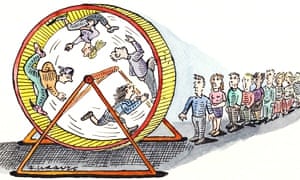
It is staggering how many teaching staff I know that do not read examiners’ reports or even the exam specification and so their class often misses out on marks. Photograph: Alamy
The Secret Teacher in The Guardian
A detailed but incorrect answer appears beside every question on an exam sheet. The answers are peppered with technical language but their ideas make little sense. This is one of the most frustrating errors I see as an exam marker.
I took the position up a few years ago after some persuasion from a colleague and the lure of some extra holiday money. I was told that it would be excellent training and help me to become a more effective classroom teacher as I would understand the demands of the exam boards more closely.
Yes it is true that I understand the application of mark schemes better than before, and it definitely looks good on my CV. But I don’t think I can do it much longer.
Each year, I clear my diary for June and plan my time carefully to ensure that I can mark to a strict timetable, giving the papers my highest level of focus. And every year I become more and more depressed by the standard of the responses and the restrictive nature of the mark schemes.
The most saddening answers are simply left blank, or there could be a crossed out sentence. This may be understandable at GCSE for a short answer, but I have seen full essay questions left blank in A-level exams. I cannot help but picture the student sat in the exam hall, pen in hand and nothing to write. I wonder how they feel; it makes me sad and angry that maybe they’ve not had all the help they deserve from their teacher.
On another occasion a GCSE student covered a whole page in calculations trying to work out a simple percentage change question. They drew a box and arrows pointing to their eventual (wrong) answer, but they must have spent at least 20 minutes on a question that should take no more than two.
The Secret Teacher in The Guardian
A detailed but incorrect answer appears beside every question on an exam sheet. The answers are peppered with technical language but their ideas make little sense. This is one of the most frustrating errors I see as an exam marker.
I took the position up a few years ago after some persuasion from a colleague and the lure of some extra holiday money. I was told that it would be excellent training and help me to become a more effective classroom teacher as I would understand the demands of the exam boards more closely.
Yes it is true that I understand the application of mark schemes better than before, and it definitely looks good on my CV. But I don’t think I can do it much longer.
Each year, I clear my diary for June and plan my time carefully to ensure that I can mark to a strict timetable, giving the papers my highest level of focus. And every year I become more and more depressed by the standard of the responses and the restrictive nature of the mark schemes.
The most saddening answers are simply left blank, or there could be a crossed out sentence. This may be understandable at GCSE for a short answer, but I have seen full essay questions left blank in A-level exams. I cannot help but picture the student sat in the exam hall, pen in hand and nothing to write. I wonder how they feel; it makes me sad and angry that maybe they’ve not had all the help they deserve from their teacher.
On another occasion a GCSE student covered a whole page in calculations trying to work out a simple percentage change question. They drew a box and arrows pointing to their eventual (wrong) answer, but they must have spent at least 20 minutes on a question that should take no more than two.
Some students miss out on recognition because they lack the simple skill of clear handwriting; we cannot award the marks if we can’t read the answer. If it is illegible, there is no choice but to only credit the parts I can read.
Then there’s the other side of the scale: some essays are magnificent and show understanding of a topic that goes far beyond the requirements of the course. These are beautifully written and include complex analysis worthy of an undergraduate. But many of these responses go uncredited if they do not fit the exacting standard of the mark scheme.
I have seen some students get marks “capped” because they haven’t included a certain phrase or diagram, even though their overall work was of a high standard. This is reflected in the classroom and I have students asking how many sentences of analysis they need, and how many evaluation points. Whatever happened to writing a good essay and answering the question to the best of your ability?
I understand that exams are necessary to be able to award qualifications to students, and that mark schemes can ensure that grades are fair and consistent – perhaps this is something that cannot be changed. But I just cannot stop picturing the students sat in the exam halls, some with nothing to write at all, some writing illegibly, and others writing brilliantly but not being rewarded.
It’s clear something isn’t working if a student is enrolled on a course, but ends up without anything to show for it.
Some students do not engage – perhaps because they are not supported emotionally at home and in school – and cannot cope with the demands of study. Others are simply not on the right course. Even more worryingly, too many students fail to achieve because of poor teaching.
It is staggering how many teaching staff I know that do not read examiners’ reports or even the exam specification and so their class often misses out on marks.
It all boils down to time. We don’t need another initiative or want the system to change again but teachers need support to deliver well-designed courses and give detailed feedback to students. This would happen if class sizes were more manageable, reducing the level of marking we have to get through. It really is that simple.
Education and exams should not be the final stage for young people, but the start of their life. Yet, too many are beginning this journey far behind their peers. Let’s not let students down. We are measured by their results for that one year; but they may be measured by these grades for life.

 If he is to enjoy further success in international cricket, Harbhajan Singh must remember that the offbreak is his stock delivery, not the doosra © BCCI
If he is to enjoy further success in international cricket, Harbhajan Singh must remember that the offbreak is his stock delivery, not the doosra © BCCI As T20 cricket took root, Harbhajan seemed to focus more on variations and lost his zing © BCCI
As T20 cricket took root, Harbhajan seemed to focus more on variations and lost his zing © BCCI